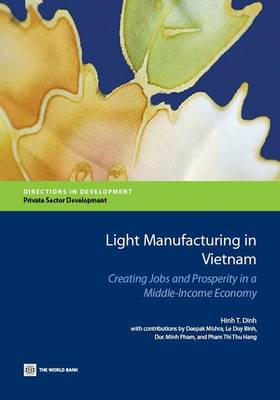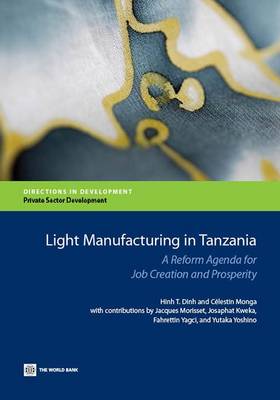Directions in development
2 total works
Light Manufacturing in Vietnam makes the case that, if the country is to continue along a rapid economic growth path and create jobs, it must undertake a structural transformation that can lift workers from low-productivity agriculture and the mere assembly of imported inputs to higher-productivity activities. Vietnam needs to address fundamental issues in the manufacturing sector that, until now, have been masked by economic growth. The book shows that there is a dichotomy between domestic enterprises and enterprises supported by foreign direct investment. The dominant state-owned enterprises and foreign-invested firms are often not integrated with smaller, domestic firms through backward or forward links in the use of domestically produced inputs or intermediate products. Growth in the domestic light manufacturing sector has arisen from the sheer number of micro and small enterprises rather than from expansion in the number of medium and large firms. As a consequence, final products have little value added; technology and expertise are not shared; and the economy has failed to move up the structural transformation ladder. This structure of production is one of the reasons Vietnam's rapid process of industrialisation over the last three decades has not been accompanied by a favourable trade balance. Policy measures to address problems in competitiveness in Vietnam must confront the dual structure of the light manufacturing sector, while raising the value added in the industry. To that end, measures must be taken to nurture the expansion of small domestic firms, while helping these firms to achieve greater productivity through trade integration. This will require improvements in labour skills and technology and in the quality and variety of products able to compete with imports.
Light Manufacturing in Tanzania argues that for Tanzania to remain one of the fastest growing economies in Sub-Saharan Africa, it has to make progress in the structural transformation that can lift workers from low-productivity agriculture and the informal sector to higher productivity activities. Manufacturing, which has been the main vehicle throughout the world to achieve this transformation, has remained stunted in Tanzania. Using new evidence, the book shows that feasible, low-cost, sharply focused policy initiatives aimed at enhancing private investment could launch Tanzania on a path to competitive light manufacturing. These initiatives would complement progress on broader investment reforms by increasing the share of industry in regional output and raising the market share of domestically produced goods in rapidly growing local markets for light manufactures. And, as local producers increase their scale, improve quality, and gain experience with technology, management, and marketing, they can take advantage of emerging export opportunities. In Tanzania, as in East Asia, policies that encourage foreign direct investment can speed industrial development and the expansion of exports. The impact of isolated successes can be multiplied. The strategies proposed here can launch a process that would create millions of productive jobs. Light Manufacturing in Tanzania has several innovative features. First, it provides in-depth cost comparisons between Tanzania and four other countries in Asia and Africa at the sector and product levels. Second, the book uses a wide array of quantitative and qualitative techniques to identify key constraints to enterprises and to evaluate differences in the performance of firms across countries. Third, it uses a focused approach to identify country - and industry - specific constraints. Fourth, it highlights the interconnectedness of constraints and solutions. For example, solving the manufacturing input problem requires actions in agriculture, education, and infrastructure. Detailed cross-country analysis was carried out in four subsectors in Tanzania: textiles and apparel, leather products, wood products, and agroprocessing. Based on this analysis, the book suggests directing government policies toward removing constraints in a few of the most promising light manufacturing sectors using practical and innovative solutions inspired by the fast-growing Asian economies.

